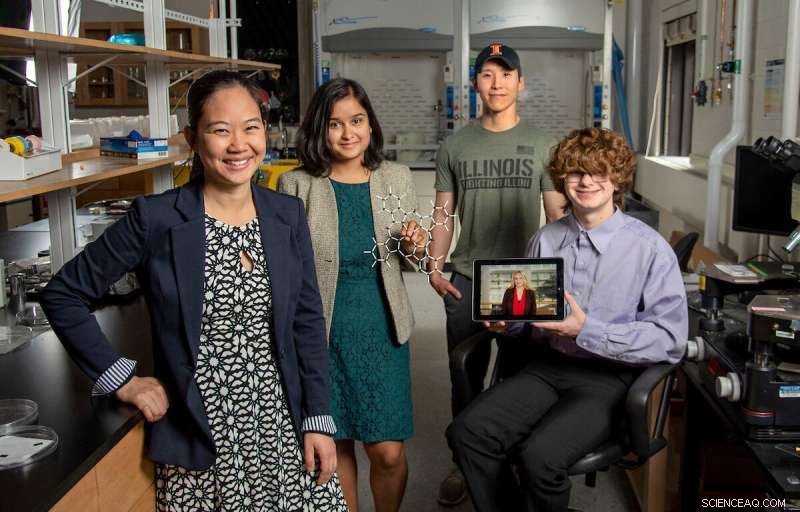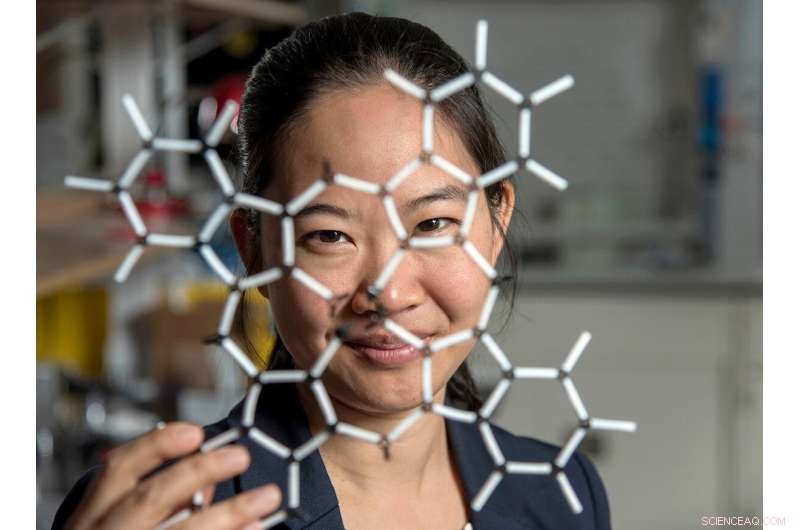
Pinshane Huang, en el extremo izquierdo, se une a Priti Kharel, segunda desde la izquierda, Justin Bae y Patrick Carmichael, en el extremo derecho, en el Laboratorio de Investigación de Materiales. En la tableta aparece Blanka Janicek. Crédito:Heather Coit/Colegio de Ingeniería de Grainger
Un esfuerzo de investigación de la Universidad de Illinois Urbana-Champaign dirigido por Pinshane Huang está acelerando las técnicas de imagen para visualizar claramente las estructuras de las moléculas pequeñas, un proceso que antes se creía imposible. Su descubrimiento libera un potencial infinito para mejorar las aplicaciones de la vida cotidiana, desde plásticos hasta productos farmacéuticos.
El profesor asociado del Departamento de Ciencia e Ingeniería de Materiales se ha asociado con los coautores principales Blanka Janicek, exalumna de 2021 y posdoctorado en el Laboratorio Nacional Lawrence Berkeley en Berkeley, California, y Priti Kharel, estudiante graduada del Departamento de Química, para probar la metodología que permite a los investigadores visualizar pequeñas estructuras moleculares y acelerar las técnicas de imagen actuales.
Los coautores adicionales incluyen al estudiante graduado Sang hyun Bae y los estudiantes universitarios Patrick Carmichael y Amanda Loutris. Su investigación revisada por pares se ha publicado recientemente en Nano Letters .
Los esfuerzos del equipo exponen la estructura atómica de la molécula, lo que permite a los investigadores comprender cómo reacciona, conocer sus procesos químicos y ver cómo sintetizar sus compuestos químicos.
"La estructura de una molécula es tan fundamental para su función", dijo Huang. "Lo que hemos hecho en nuestro trabajo es hacer posible ver esa estructura directamente".
La capacidad de ver la estructura de una molécula pequeña es vital. Kharel comparte cuán vital es dando el ejemplo de un medicamento conocido como talidomida.
Descubierta en los años 60, la talidomida se recetaba a mujeres embarazadas para tratar las náuseas matutinas y luego se descubrió que causaba defectos de nacimiento graves o, en algunos casos, incluso la muerte.
¿Qué salió mal? El fármaco tenía estructuras moleculares mixtas, una responsable de tratar las náuseas matutinas y la otra, lamentablemente, causaba efectos adversos devastadores para el feto.
La necesidad de una ciencia proactiva, no reactiva, ha instado a Huang y a sus estudiantes a continuar con este esfuerzo de investigación que originalmente comenzó con pura curiosidad.
"Es tan crucial determinar con precisión las estructuras de estas moléculas", dijo Kharel.
Por lo general, las estructuras moleculares se determinan con técnicas indirectas, un enfoque difícil y lento que utiliza resonancia magnética nuclear o difracción de rayos X. Peor aún, los métodos indirectos pueden producir estructuras incorrectas que dan a los científicos una comprensión errónea de la composición de una molécula durante décadas. The ambiguity surrounding small molecules' structures could be eliminated by using direct imaging methods.
In the last decade, Huang has seen significant advancements in cryogenic electron microscopy technology, where biologists freeze the large molecules to capture high-quality images of their structures.
"The question that I had was:What's keeping them from doing that same thing for small molecules?" Huang said. "If we could do that, you might be able to solve the structure (and) figure out how to synthesize a natural compound that a plant or animal makes. This could turn out to be really important, like a great disease-fighter," Huang said.
The challenge is that small molecules are often 100 or even 1,000 times smaller than large molecules, making their structures difficult to detect.
Determined, Huang's students began using existing large molecule methodology as a starting point for developing imaging techniques to make the small molecules' structures appear.
Unlike large molecules, the imaging signals from small molecules are easily overwhelmed by their surroundings. Instead of using ice, which typically serves as a layer of protection from the harsh environment of the electron microscope, the team devised another plan for keeping the small molecules' structures intact.

Pinshane Huang and her researchers discovered how to view structures in molecules, which opens a whole new realm of scientific possibilities. Credit:Heather Coit/The Grainger College of Engineering
How can you temper a molecule's environment? By using graphene.
Graphene, a single layer of carbon atoms that form a tight, hexagon-shaped honeycomb lattice, dissipates damaging reactions during imaging.
Stabilizing the small molecule's environment was only one issue the Illinois researchers had to manage. The team also had to limit its use of electrons, as low as one-millionth the number of electrons normally used, to illuminate the molecules.
Low doses of electrons ensure that the molecules are still moving enough for the researchers to capture an image.
"The way I like to think about it is the molecule doesn't like to be bombarded by higher-energy electrons, but we need to do that to be able to see the structure, and graphene helps dissipate some of that charge away from the molecule so that we can actually get a nice image of it," Janicek said.
Unfortunately, once captured, the molecules were nearly invisible in the image.
"When they take a low-dose image, it initially looks like noise or TV static—almost like nothing is there," Huang said.
The trick was to isolate the atomic structures from that noise by using a Fourier transform—a mathematical function that breaks down the small molecule's image—to see its spatial frequency.
"We took images of hundreds of thousands of molecules and added them together to build a single, clear image," Kharel said.
This averaging approach allowed the team to create crisp images of the molecules' atoms without damaging the integrity of any individual molecule.
"Month after month, week after week, our resolution improved," Huang said. "And then one day, my students came in and showed me the individual carbon atoms—that's a major achievement. And of course, it comes after all this deep knowledge that they have gained to design an imaging experiment and how to unlock data from what looks like nothing."
This collective discovery is paving the way for many more structural molecule imaging findings.
"There's been this whole field of small molecules that have been left out in the cold, so to speak. We're shining a light on how do we get there as a field? How do we make this thing that for us right now is so hard?" Huang said. "One day it won't be—that's the hope."
The Illinois researchers' efforts are the first big step in turning that dream into reality.
"One day, this will be the way we solve the structure of a small molecule," Huang said. "People will simply throw the molecule in the electron microscope, take a picture and be done."
That dream inspires Huang and her Illinois team to keep the course.
"That's potentially life-changing, and we've made it exist," Huang said. "We haven't yet made it easy, but imaging techniques like this will change so much of science and technology." ESR-STM en moléculas individuales y estructuras basadas en moléculas